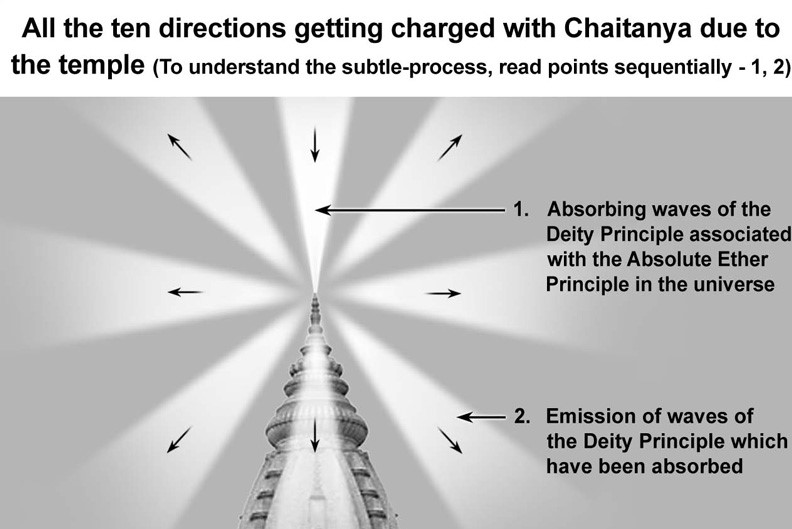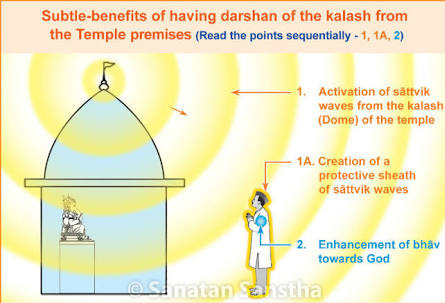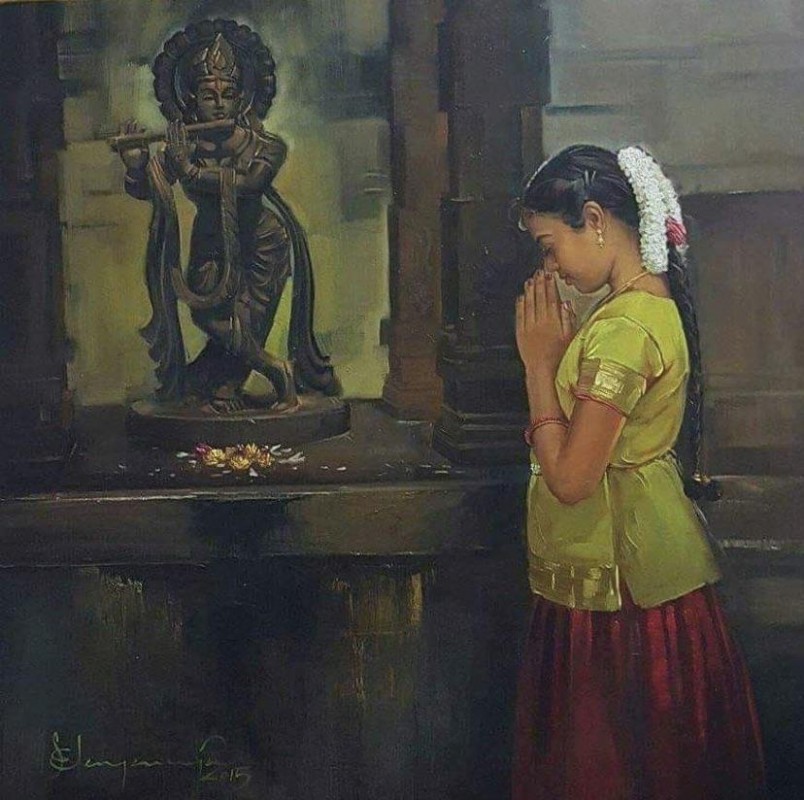According to the Hindu Scriptures, the sight (Darshanam) of the Deity (दर्शनम्) is an experience of grace & connection arising from the sight of a holy being or idol. The sight (Darshanam) of the Deity (दर्शनम्) implies a mutual interaction between the viewer & the perceived object or being (i.e., the idol). Although it requires nothing more than the performance of seeing. The sight (Darshanam) of the idol (दर्शनम्) is considered as the most powerful form of worship & process of spiritual fulfilment.
Even when the devotee is not in the temple, they continue to pray & talk to this visual memory of the Deity throughout the day. This process is supremely useful & is known as “Contemplation”. The more one visits the temple & see the same Deity, the communication & the connection becomes stronger & stronger.
The sight (Darshanam) of the Deity (दर्शनम्) refers to the act of beholding the Deities & divine personalities with great respect & adoration. This is also extended to places & objects which have been sanctified by their holy presence. Darshanam (दर्शनम्) is the Sanskrit word, derived from the Sanskrit verb-root ‘दृश्- पश्यति’ (Drush- Pashyati), which means to see or perceive or sight or vision.
According to the Hindu Scriptures, a miraculous & very personal form of puja is the experience of the sight of the Deity (Darshanam) (दर्शनम्). This connection opens the heart & bestows peace, blessings, boons & divine energy. At the moment of the sight of the Deity (Darshanam) (दर्शनम्), the entire focus of the devotee is absorbed in the image/ idol of the Deity. The experience is deepened by the belief that the person who receives the sight of the Deity (Darshanam) (दर्शनम्) is also seen by the Deity.
The sight of the Deity (Darshanam) (दर्शनम्) represents one of the most basic & fundamental forms of worship in Hinduism. When a Hindu goes to the temple, he does not say that 'I am going for worship', but rather he says 'I am going for darshan'. The sight of the Deity (Darshanam) (दर्शनम्) is a two-way flow of vision. While the devotee sees the Deity, so too the Deity sees the devotee, & the two make contact through their eyes & energy.

Picture Courtesy- Adhyatma Vishwavidyalay
Significance of having the sight of the Deity (दर्शनम्) at the temple -
In the temple the idol of the Deity that is been transformed in a special ceremony by an enlightened pujari into a living presence of that Deity by the installation of the Vital Breath (प्राण प्रतिष्ठा) (Praana Pratishtha). Then that transformed idol is considered as the Sacred Idol (मूर्तिः) i.e. a real, breathing embodiment of the Deity & treated with respect. The Sacred Idol (मूर्तिः) of the Deity is always ritually bathed with water & milk, anointed with precious oils, dressed in silks & adorned with jewellery & flowers by the pujari of the temple. Thus, having the sight of the Deity (Darshanam) (दर्शनम्) at the temple is more important than having the sight of the Deity (Darshanam) (दर्शनम्) at home as, at the home the Sacred Idol (मूर्तिः) of the Deities are not gone through the special ceremony of the installation of the Vital Breath (प्राण प्रतिष्ठा).
With the living presence of the Deities within the Sacred Idol (मूर्तिः), the sight of the Deity (Darshanam) (दर्शनम्) takes on another powerful meaning. For not only does the devotee come to behold the Divine in the Sacred Idol (मूर्तिः), but simultaneously, it is an opportunity for teh devotees to be seen by the Deities themselves. This reciprocation of ‘seeing’ & ‘being seen’ is a profoundly enriching & fulfilling aspect of the devotee-Deity relationship made possible through the sight (दर्शनम्) of the Sacred Idol (मूर्तिः) in the temple.
While engaged in the sight (Darshanam) (दर्शनम्) of the Deity, devotees will join their palms & bow their heads as an expression of their salutation & modesty before the Deities. This gesture is called Pranam (प्रणामः), & is a gesture one sees often among Hindus, even as a form of respect when greeting or bidding to friends, family & guests.
Traditionally, while visiting the temple, men should wear dhoti with kurta or kurta-pyjama & women should wear saree or Punjabi suit or any such traditional clothes but western dresses are not acceptable in the temples in Hinduism, still I have seen many people wearing western clothes while going to the temple which is not acceptable from our Scriptures & Vedas.

Correct way of having the sight of the Deity (दर्शनम्) at the temple-
When the devotee enter the temple they should join their hands & have a look at the Deity for few minutes. Do not close the eyes as the Darshanam (दर्शनम्) word itself suggests the sight or the vision of the Deity. How can we see the Deity if we close our eyes! Keeping eyes open is the most important part of this Hindu ritual. During the sight of the Deity (दर्शनम्), many people recite the shloka. That shloka is;
अनायासेन मरणं विना दैन्येन जीवनम्।
देहान्ते तव सानिध्यं देहिमे परमेश्वर।।
Meaning- O God! Please bestow upon me the death without effort, life without poverty & proximity (closeness) towards You at the end of my life.
After having the sight of the Deity (दर्शनम्) one should bend a bit with joined hands (act of doing प्रणामः) & at that time one can close eyes for few seconds while touching the thumb in between the eye brows. After having the sight of the Deity (दर्शनम्), we must have seen many people sitting near the entrance or the stairs of the temple for few minutes & even our elders taught us to do so. Do you know why? When we sit for few minutes, we should close our eyes for few minutes & visualize the whole form of the Deity which is recently perceived during the sight of the Deity (Darshanam) (दर्शनम्). This whole process is the act of the sight of the Deity (Darshanam) (दर्शनम्).
The act of the sight of the Deity (Darshanam) (दर्शनम्) is also done of the Sacred Rivers (e.g. river Ganga, river Narmada, etc.) Sacred Mountain (e.g. mount Kailas, mount Govardhan, etc.), Sacred tree (e.g. peepal tree, banyan tree, etc), the Sun (i.e. rising Sun), the Moon & of the living guru or saints. The sight of the Deity (दर्शनम्) of the living guru or saints are so valued that people wait in the ashram for hours for the glance or gaze lasting for few seconds or moment.
Other rituals associated with the sight of the Deity (Darshanam) (दर्शनम्) includes, circumambulation (or walking clockwise) (प्रदक्षिणा) around the Deity or the shrine, fivefold bowing (Panchang Pranam) (पञ्चाङ्ग प्रणामः) or prostrated bowing (साष्टाङ्ग दण्डवत् प्रणामः) (Sashtang Dandvat Pranam) is done by the devotees in an expression of deep humility, respect & kindness. It symbolizes the conscious offering of one’s self through body, speech & mind to the Deities.
The spiritual or divine connection what we persive during the sight of the Deity (Darshanam) is not the same experience to everyone. Each one of us are unique & each one of us have unique spiritual connection because of which, some experience an internal transformation, others find a sense of healing, and still, others feel an overwhelming sense of love & acceptance or some feel extraordinary spiritual connection or sometimes, people don’t feel anything at all. Every single person experiences something different & receives something different, entirely unique to them.
Regardless of the individual experience, one thing remains constant in each sight of the Deity (Darshanam) & that is, the sharing of unconditional Divine Love. When we look at the idol of the Deity, that Deity in return bless us with his divine form & boosts our spiritual connection with the Deity.

Picture Courtesy- Sanatan Sanstha
Scientific benefits of having the sight of the Deity (दर्शनम्) at the temple -
1. Basically, there is pure science behind the architecture of temples, which are constructed in such a manner that there are high positive magnetic waves at the center point of the temple, the “garbhagruha”, where the main idol is placed.
2. The positivity of the surrounding affects the mind & body positively.
3. Having the sight of the Deity (दर्शनम्) in the temple helps to get relaxed & calm mind as the surrounding area of the temple is always peaceful.
4. It wards off negative thoughts & negative energy.
5. It helps absorbing the positive thoughts & energy which are created within the temple.
6. When the sight of the Deity (दर्शनम्) is done & in return the Deity also see his devotees, the subtle positive vibration enters the devotees through the Deity's vision, those entered positive vibrations transforms into good wishes & blessing received from the Deities.
7. The surrounding of the temple is always covered with trees & plants which helps in breathing fresh oxygen.
8. While having the sight of the Deity (दर्शनम्) at the temple, the disturbed thoughts gets more balanced & reviving.
9. It helps to get spiritually connected to the Deity.
10. It helps in improving mood & unburdens stress, tension & anxiety.
11. Temple bells are made of a combination of metals like lead, copper, cadmium, zinc and nickel. The ringing of the bell creates a pleasing chiming sound that helps calm you down. "The hearing sense is activated when you ring the temple bell. The sound creates harmony between both the hemispheres of the brain.
12. Temples are built according to the Vastu Shastra, which aligns their structure with the Earth’s magnetic grid. This sacred geometry ensures that energy flows in a way that enhances human consciousness.
13. Many Hindu temples contain Yantras, which are geometric patterns carved in stone or metal plates placed beneath the main idol. These Yantras store & radiate cosmic energy, influencing the energy field of the temple and when we enter the temple our body becomes the reciver of that energy & viberation.
Thus, one simple custom of our Hindu daily ritual enhances not only positivity in our mind & body but also helps to get more connected & to get closer to that particular Deity. We hope that next time you visit any temple you will perceive the sight of the Deity with full faith & true understanding of this particular ritual.
ज्येष्ठः शुक्लपक्षे १०, २०७६
